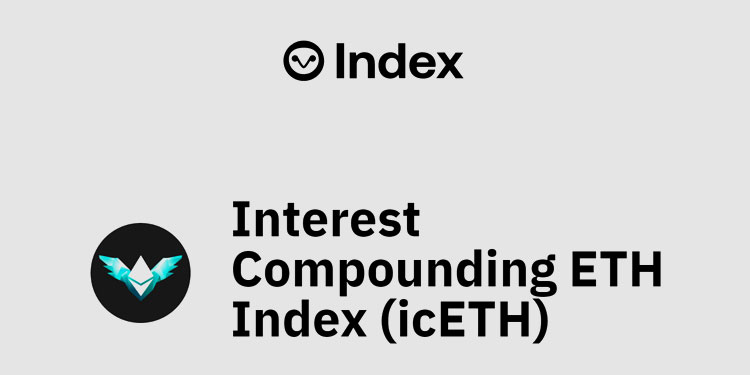The Index Coop, a provider of one-token exposure to popular crypto themes, today announced the launch of its first yield product: Interest Compounding ETH ($icETH).
icETH provides an enhanced yield on ETH using a leverage liquid staking strategy built on Set Protocol. Within Aave v2, icETH deposits Lido’s liquid staked Ethereum token—stETH—as collateral and recursively borrows ETH to procure more stETH. As a result, token holders have spot exposure to ETH and nearly twice the yield compared to simply holding stETH.
It is worth noting that the effective yield for icETH is variable and subject to staking rates and borrowing costs. icETH is built on the same battle-tested leverage token infrastructure as the FLI tokens, which abstracts collateralized debt management, automates rebalancing, and minimizes liquidation risk.
Yet, the risk profile of icETH is significantly lower than that of the FLI tokens because of the high correlation between the collateral and debt assets.
For example, ETH2x-FLI uses ETH as collateral and USDC as debt, and the inherent price volatility of ETH compared to USDC requires daily rebalancing to maintain a healthy LTV ratio. Compare that to icETH, which uses stETH as collateral and ETH as debt.
Because the price of both tokens moves in tandem, the LTV ratio is stable and only requires rebalancing every few months. The result is lower liquidation risk and less volatility decay for icETH, enhancing fund safety and preserving NAV.
ETH is the most prominent and liquid asset in DeFi. With a market cap of $337B and an average annual return of 194% over the last 5 years, many investors are eager to compound their ETH holdings.
Staking is arguably the best way to earn a yield on ETH, and tokens like stETH simplify the staking process by offering a liquid, interest-bearing token.
However, with stETH enabled as collateral on Aave, icETH holders can easily access leveraged yield on their ETH in a simpler and safer way than doing so manually.
There are 4 major benefits to using icETH:
- Minimized (though not eliminated) risk
- Lower gas fees
- Ease of use
- Composability with DeFi protocols
Minimized Risk
While there is an inherent risk with using leverage, the high correlation between icETH’s collateral (stETH) and debt (ETH) assets significantly lowers liquidation risk. There are also multiple safety mechanisms in place to maintain a healthy LTV ratio and mitigate risk.
If the leverage ratio were to move outside of the safe range defined for the product (3.0x – 3.3x), it would recenter automatically to the target leverage ratio (3.1x). Allowing the leverage ratio to float within this safe range minimizes rebalancing as well, preserving funds and diminishing NAV decay.
icETH also utilizes an incentivized, emergency de-levering mechanism —referred to as ‘ripcord’— as another safety layer in case of black swan events. If the current leverage ratio for icETH surpasses 3.5x, the publicly callable ripcord function would aggressively recenter the index to avoid liquidation.
Lastly, in the event that ETH borrowing costs in Aave surpass the staking yield on stETH, icETH can be delivered so that the effective yield on the index does not fall below the staking yield for stETH.
Lower Fee Burden
Compared to executing this strategy manually, icETH holders save significantly on gas fees.
Rather than submitting a dozen different transactions in Aave and different DEXs, users can simply buy the icETH token and benefit from the socialized gas costs. Also, with a streaming fee of 0.75%, icETH is the lowest cost option compared to tokens and vaults that use a similar strategy or offer a comparable yield.
Ease of Use
Best of all, icETH is exceptionally easy to use. Simply buy and sell like you would any other token for leveraged liquid staking abstracted into a single token! Because icETH rebalances your position for you, constant monitoring or management is not required.
Composability
Because icETH is a fully collateralized ERC-20 token, it can be integrated into several different DeFi protocols and platforms to expand its utility and use cases.
Under the hood, icETH is built on Aave v2, the borrowing/lending protocol that enables the creation of the collateralized debt position.
Understanding the Methodology
Like all Index Coop products, icETH follows a strict methodology.
The smart contracts supporting icETH are programmed to manage the collateral and debt positions in an automated fashion by targeting a specific leverage ratio and allowing it to fluctuate within a safe range before recentering back to the target ratio.
Initial parameters for icETH:
- Collateral Asset: stETH
- Borrow Asset: ETH
- DeFi Lending Protocol: Aave v2
- Target Leverage Ratio: 3.1x
- Maximum Leverage Ratio: 3.3x
- Minimum Leverage Ratio: 3.0x
- Rebalance Interval: LR < 3.0 or > 3.3
- Recentering Speed: 100%
- Token Supply Cap: 15,000
Because the collateral balance is expected to gradually appreciate relative to debt, the index will rebalance when the leverage ratio falls below the minimum threshold and must return to the target leverage ratio.
Fees
icETH will have a streaming fee of 0.75% (75 bps), no mint fee, and a redeem fee of 0.25% (25 bps).
How to Buy / Mint
Buy: Index Coop | Uniswap
Mint: Index Coop | TokenSets
Liquidity
The Index Coop has seeded a 0.05% icETH / ETH pool on Uniswap v3, which can currently support a $150k icETH purchase with less than 1% slippage.
Token holders are also able to provide liquidity through this G-uni pool powered by Gelato, which manages the LP position parameters for you. Please note that this is a third-party service and that the Index Coop does not control this g-uni pool.
About Index Cooperative:
The Index Cooperative is an awarded decentralized finance startup and Web3 community powering crypto index products that can be purchased on the blockchain.
Index Cooperative products provide one-token exposure to popular crypto themes such as decentralized finance, the Metaverse, and the Web3 data economy.
As of April 7th, 2022, Index Cooperative products have an aggregate Total Value Locked (TVL) of approximately $221mm.3
